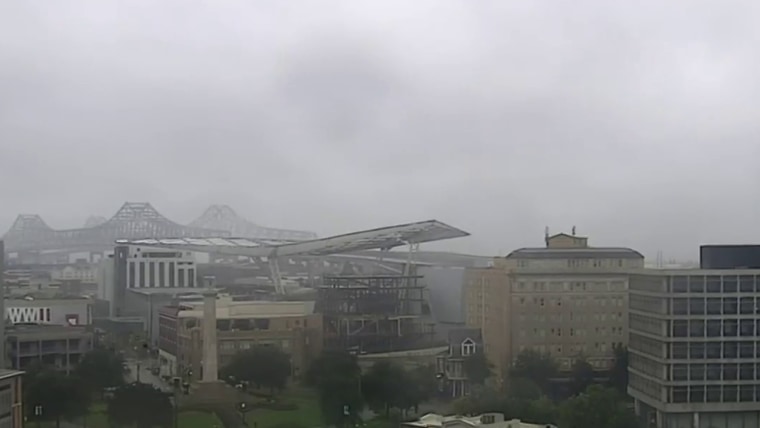Exactly 16 years after Hurricane Katrina slammed New Orleans, leaving more than 1,800 people dead and becoming one of the costliest storms in American history, another major storm on Sunday was bringing punishing wind and heavy rain to southeast Louisiana.
Hurricane Ida, which made landfall near Port Fourchon, Louisiana, as a Category 4 hurricane with maximum sustained winds of about 150 mph, has drawn comparisons to its deadly predecessor, with both making landfall in the same part of Louisiana. Experts said it is the strongest test yet for the systems in place since Katrina.
“It's definitely an odd thing to be watching this hurricane on the 16-year anniversary of Hurricane Katrina's landfall at virtually the same place,” said Brian McNoldy, a senior research associate with the University of Miami who studies hurricanes.
But there are key differences in the two storms, and officials have sought to allay fears that Ida would be a sequel to Katrina by pointing to improvements made to the levee system following the 2005 storm to better prepare southeast Louisiana and the New Orleans metro area for the storm surge.
Hurricane Katrina “changed this city forever” but “we are much better protected than we were during Katrina, the levees are stronger, they're higher,” Kelli Chandler, the regional director of the Southeast Louisiana Flood Protection Authority, said on MSNBC Sunday.
“We may have some local street flooding, and we will have widespread power outages. We've already started experiencing that,” she said. “But we are much better protected from storm surge than we were 16 years ago.”
Ida, which reached land as a Category 4 storm compared with Katrina's Category 3, is expected to produce a less severe storm surge.
Hurricane Katrina was a “huge storm” with a “very expansive” wind field compared to an average storm, McNoldy said. It also produced a record storm surge of about 24 to 28 feet along the Mississippi coast. Current estimates put Ida’s storm surge as high as 12 to 16 feet.
Hurricane Ida strengthened rapidly in the hours before it made landfall, whereas Katrina did the opposite, strengthening to a Category 5 over the Gulf of Mexico before weakening to a Category 3 storm when it made landfall in 2005, McNoldy said.
“Hurricane Katrina was not as intense when it made landfall, but it was significantly larger, and had more energy associated with it,” McNoldy said.
As NBC News senior meteorologist Kathryn Prociv put it, that’s “why we always say, don't focus on the category because you can get those far-reaching and deadly impacts despite it being a 3 versus a 5, for example.”
“Katrina was much bigger, but both of them are destructive hurricanes that are going to go down in history, unfortunately,” she said.
Prociv said the two storms made landfall only about 50 miles away from each other, with Katrina making landfall near Triumph, Louisiana, and Ida making landfall farther west over Port Fourchon. Despite the close proximity at landfall, the storms are taking different tracks. Ida landed on the west of the Mississippi River in Louisiana, instead of on the east side near the coast of Mississippi.
Ida, which had stronger winds at landfall — 150 mph, compared with 125 mph for Katrina — is expected to bring more severe wind and rain as it crosses land. It is the second storm in as many years to make landfall in Louisiana with winds of 150 mph, she said, following last year's Hurricane Laura.
Part of what made Katrina such a catastrophic storm was that it pushed the levee system in New Orleans to failure, flooding about 80 percent of the city and leading to 1,800 deaths. Officials sought to assure Louisiana residents and the public that a repeat of those conditions was unlikely to happen with Ida because of multi-billion investment in infrastructure since the 2005 storm.
Louisiana Gov. John Bel Edwards said on CBS’ “Face the Nation” Sunday that $14 billion was invested in the system after Katrina and that officials “feel very good about what's inside the hurricane risk reduction system.”
He said the state has lesser systems of protection along the coast where the levees are not as high and are not as fortified and “we're very concerned there.”
The National Hurricane Center said Sunday that “overtopping of local levees outside of the Hurricane and Storm Damage Risk Reduction System is possible” where local inundation values may be higher than those shown predicted in its advisory.
“This would be a tremendous test of those systems and quite frankly it's going to be the strongest test we've had yet for the current hurricane and storm risk reduction system itself,” he said.
During a news conference Sunday, Ramsey Green, the deputy chief administrative officer for infrastructure with New Orleans, said it was important to acknowledge the city was in a different place than it was when Katrina struck.
“Our levee system is strong, one of the top protected systems on the planet,” he said, adding they have great confidence in the current system.
McNoldy, the hurricane researcher, said with much of the impact of this storm still to come, “one lesson to learn from that is, let's wait till it's over to cheer that it all held up.”
"news" - Google News
August 30, 2021 at 04:02AM
https://ift.tt/3gHYjFN
How will Hurricane Ida compare to Hurricane Katrina as storm makes landfall on anniversary - NBC News
"news" - Google News
https://ift.tt/2DACPId
https://ift.tt/2Wh3f9n
Bagikan Berita Ini















0 Response to "How will Hurricane Ida compare to Hurricane Katrina as storm makes landfall on anniversary - NBC News"
Post a Comment